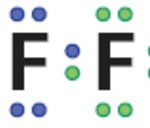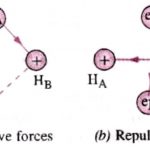Non-polar covalent bonds If two similar atoms come close to each other and form a bond by sharing their electrons, the shared electrons are equally attracted by the two atoms as the electronegativity of the atoms is same. Hence no poles are developed. This leads to the formation of completely non-polar bonds. If two hydrogen atoms form a bond, the electron pair will … [Read more...] about Polar and Non-Polar Covalent Bond
Chemical Bonding and Molecular Structure
Bond Characteristics
Bond Length When atoms come closer to each other, attraction takes place between them and ,therefore, the potential energy of the system keeps on decreasing till at a particular distance, the potential energy is minimum. If the atoms are further brought closer ,the repulsion start and therefore, the potential energy of the system begins to increase. At equilibrium … [Read more...] about Bond Characteristics
Types of Covalent Bond
Depending upon the type of overlapping, the covalent bonds are mainly of two types: Sigma bond (σ) When a bond is formed between two atoms by the overlap of their atomic orbitals along the internuclear axis, the bond formed is called sigma bond The overlapping along the internuclear axis can take place in any one of the ways: (1) s-s overlapping Overlapping … [Read more...] about Types of Covalent Bond
Valence Bond Theory
This theory was put forward by Heitler and London in 1927 and was further developed by Pauling and others. In terms of energy When the two atoms are far apart from each other there is no interaction between them. When they come closer to each other ,the new forces come into operation. These forces are of two types: 1)The forces of repulsion between the nuclei of … [Read more...] about Valence Bond Theory
Valence Shell Electron Pair Repulsion Theory
The first simple theory that was put forward to explain the shape of the molecule is known as Valence Shell Electron Pair Repulsion Theory. This theory was given by Sidgwick and Powell in 1940. 1) The central atom is linked to other atoms by covalent bonds which are formed by sharing of electrons. 2) The central atom is surrounded by a shared pair of electrons and … [Read more...] about Valence Shell Electron Pair Repulsion Theory



